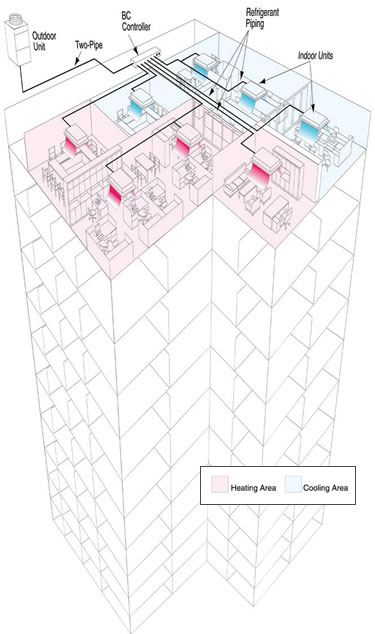
Towson City Center, a 15-story office high-rise in Towson, MD, sat vacant for ten years after being declared a sick building due to ventilation problems. In 2012, however, Caves Valley Partners acquired the building and set about planning an extreme makeover including a new VRF zoning system.
Using refrigerant as the cooling and heating medium, Variable Refrigerant Flow (VRF) zoning systems cool or heat each room or zone individually only to the level needed. VRF systems work in both new construction and retrofit projects, and are most often seen in healthcare, education, hospitality, multifamily, and mixed-use facilities. The technology has been available in the United States for approximately 10 years.
Traditional heating and cooling systems typically require high amounts of energy to force air from a central blower to a room through a complex system of ductwork. With a VRF system, one outdoor condensing unit is connected to as many as 50 indoor fan-coil units through small piping and electrical wiring (in many cases, one indoor unit can be serviced while other units within the same piping system are still working). An inverter-driven (variable speed) compressor in the outdoor unit responds to indoor temperature changes. The compressor varies its motor rotation speed and capacity accordingly, and the indoor fan-coil units vary their capacity as well.
 VRF systems deliver only the capacity necessary to meet requirements of the specific zone. Headers and T–branches make the piping design fairly simple, and allow for flexibility when placing piping and indoor units. These systems can be managed in two ways: with a remote controller located in a specific zone (each zone has its own controller), or through the centralized controller.
VRF systems deliver only the capacity necessary to meet requirements of the specific zone. Headers and T–branches make the piping design fairly simple, and allow for flexibility when placing piping and indoor units. These systems can be managed in two ways: with a remote controller located in a specific zone (each zone has its own controller), or through the centralized controller.
According to Mitsubishi Electric, on average, VRF zoning systems use 30 to 40 percent less energy than a traditional heating and cooling system. They also allow for simultaneous operation, offering cooling and heating at the same time. This can further enhance energy use by using heat within the building that is normally rejected by the condenser.
VRF in Action
Built in 1967, Towson City Center, a 15-story office high-rise in Towson, MD, sat vacant for ten years after being declared a sick building due to ventilation problems. In 2012, however, Caves Valley Partners acquired the building and set about planning an extreme makeover reusing the existing steel and concrete structure with a state-of-the-art modernization program to bring it up to code and make it a high-quality, Class A office building. The renovation included a new glass curtain wall façade and replacement of the mechanical and electrical systems – complete with a new VRF zoning system. Today, the sparkling, 170,000-square-foot tower is fully leased and home to the Towson University Institute for Well Being and MileOne Automotive.
The VRF system helped the building earn LEED points toward its Silver certification. The system was also a good fit for the project due to its low-profile indoor fan-coil units, which helped overcome the height limitations posed by the building’s low decks. Instead of a typical 14-foot space between floors, the 12 floor slabs measured only 10-feet-6-inches, allowing less than nine feet of clearance below the existing structure. This already low ceiling height meant that an HVAC solution that required significant ductwork was off the table.
Originally, all 12,000 square feet of the penthouse floor were dedicated to the facility’s mechanical room. With the small footprint offered by the VRF system, the building’s 15 units were able to fit on the roof to make the penthouse floor available for storage as well as a water-cooled Glycol loop in case a tenant wanted to add a data center. The original shaft space required by the outdated system was also filled in, increasing the square footage available to lease on each floor.
New in HVAC: DEVAP Air Conditioning
Developed by the National Renewable Energy Laboratory (NREL) in 2011, the DEVAP (desiccant-enhanced evaporative air conditioner) separates hot air into two streams. A liquid desiccant dries one air stream; the other air stream is humidified. The streams combine to create cool, dry air without any coolant required. The NREL estimates that DEVAP reduces air-conditioning energy usage by 40 to 90 percent in commercial buildings. Because of the lack of a compressor or pressurized system to contain refrigerant, DEVAP is predicted to be a simpler system to maintain and service. It is also expected to provide better temperature and humidity control than standard air-conditioning systems because it treats each separately.
Photo courtesy of Caves Valley Partners

